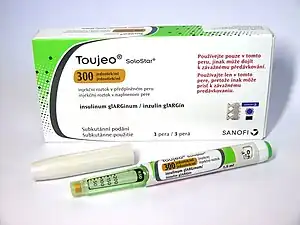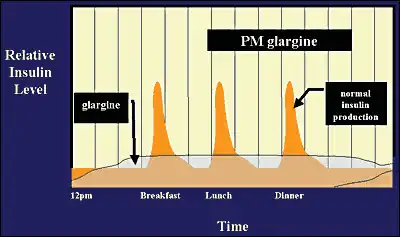Insulin glargine
 Toujeo branded insulin glargine | |
| Names | |
|---|---|
| Trade names | Lantus, Toujeo, Abasaglar, others |
IUPAC name
| |
| Clinical data | |
| Drug class | Insulin (long acting)[1] |
| Main uses | Diabetes[1] |
| Side effects | Low blood sugar, problems at the site of injection, itchiness, weight gain[1] |
| WHO AWaRe | UnlinkedWikibase error: ⧼unlinkedwikibase-error-statements-entity-not-set⧽ |
| Pregnancy category |
|
| Routes of use | Subcutaneous |
| Onset of action | ~1 hours[1] |
| Duration of action | 24 to 36 hours[1] |
| Defined daily dose | 40 units[2] |
| External links | |
| AHFS/Drugs.com | Monograph |
| MedlinePlus | a600027 |
| Legal | |
| License data |
|
| Legal status | |
| Chemical and physical data | |
| Formula | C267H404N72O78S6 |
| Molar mass | 6063 g·mol−1 |
Insulin glargine, marketed under the names Lantus among others, is a long-acting insulin, used in the management of type I and type II diabetes.[1] It is typically the recommended long acting insulin in the United Kingdom.[4] It is used once a day as an injection just under the skin.[1] Effects generally begin an hour after use.[1]
Common side effects include low blood sugar, problems at the site of injection, itchiness, and weight gain.[1] Other serious side effects include low blood potassium.[1] NPH insulin rather than insulin glargine is generally preferred in pregnancy.[4] After injection microcrystals slowly release insulin for about 24 hours.[1] This insulin causes body tissues to absorb glucose from the blood and decreases glucose production by the liver.[1]
Insulin glargine was approved for medical use in the United States in 2000.[1] It is on the World Health Organization's List of Essential Medicines.[5] In the United States the wholesale cost per 100 units is about US$26 as of 2018.[6] In the United Kingdom this amount costs the NHS about £2.35.[4] In 2017, it was the 33rd most commonly prescribed medication in the United States with more than 20 million prescriptions.[7][8]
Medical uses
The long-acting insulin class, which includes insulin glargine, do not appear much better than neutral protamine Hagedorn (NPH) insulin, but do have a greater cost, making them, as of 2010, not cost effective for the treatment of type 2 diabetes.[9] It is unclear if there is a difference in hypoglycemia, given the significance of dose, and not enough data to determine any differences with respect to long term outcomes.[10] It is not typically the recommended long acting insulin in the United Kingdom.[4]
Dosage
The defined daily dose is 40 units by injection.[2]
Mixing with other insulins
Unlike some other longer-acting insulins, glargine must not be diluted or mixed with other insulin or solution in the same syringe.[11] However, this restriction has been questioned.[12]
Side effects
Common side effects include low blood sugar, problems at the site of injection, itchiness, and weight gain.[1] Serious side effects include low blood potassium.[1]
As of 2012 tentative evidence shows no association between insulin glargine and cancer.[13] Previous studies had raised concerns.[14]
Pharmacology

Mechanism of action
Insulin glargine differs from human insulin by replacing asparagine with glycine in position 21 of the A-chain and by carboxy-terminal extension of B-chain by 2 arginine residues. The arginine amino acids shift the isoelectric point from a pH of 5.4 to 6.7, making the molecule more soluble at an acidic pH and less soluble at physiological pH. The isoelectric shift also allows for the subcutaneous injection of a clear solution. The glycine substitution prevents deamidation of the acid-sensitive asparagine at acidic pH. In the neutral subcutaneous space, higher-order aggregates form, resulting in a slow, peakless dissolution and absorption of insulin from the site of injection.[16] It can achieve a peakless level for at least 24 hours.
Acceptance and repartition
Insulin glargine is formulated at an acidic pH 4, where it is completely water-soluble. After subcutaneous injection of the acidic solute (which can cause discomfort and a stinging sensation), when a physiologic pH (approximately 7.4) is achieved the increase in pH causes the insulin to come out of solution resulting in the formation of higher order aggregates of insulin hexamers. The higher order aggregation slows the dissociation of the hexamers into insulin monomers, the functional and physiologically active unit of insulin. This gradual process ensures that small amounts of insulin glargine are released into the body continuously, giving an almost peakless profile.
History
The development of insulin glargine took place at Sanofi-Aventis's biotechnology competence center in Frankfurt-Höchst. Sanofi supplies the product to over 100 countries and more than 3.5 million patients worldwide. This makes Lantus Germany's largest and most important export pharmaceutical product. Sanofi-Aventis increased its turn-over with Lantus around 28% to €2.45 million, of which €130 million was from Germany, where approximately 1.8 million people with diabetes use the product. In 2007, Lantus was the 15th highest selling pharmaceutical product in Germany.
The investment in the production of Lantus and insulin-pen-manufacturing in Frankfurt-Höchst cost €700 million. In 2008 a new manufacturing plant was established for further insulin-pen manufacturing with an investment of €150 million. At Sanofi-Aventis the production of Lantus created 3000 jobs in Berlin and Frankfurt-Höchst.
On June 9, 2000, the European Commission formally approved the launching of Lantus by Sanofi-Aventis Germany Ltd. in the entire European Union.[17] The admission was prolonged on June 9, 2005.[18]
A three-fold more concentrated formulation, brand name "Toujeo", was introduced after FDA approval in 2015.[19][20]
Society and culture
Cost
In the United States the wholesale cost per 100 units is about US$26 as of 2018.[6] In the United Kingdom this amount costs the NHS about £2.35.[4] In 2017, it was the 33rd most commonly prescribed medication in the United States with more than 20 million prescriptions.[7][8]
.svg.png.webp) Cost of insulin glargine in the United States[21]
Cost of insulin glargine in the United States[21].svg.png.webp) Insulin glargine prescriptions (US)
Insulin glargine prescriptions (US)
Patent expiry
Patent protection for insulin glargine expired in most countries in 2015. Insulin glargine from competitor Eli Lilly became available in most countries during 2015, under the brand names Basaglar (as a follow-on in the US) and Abasaglar (as a biosimilar in the EU). Biosimilar insulin glargine has only been released in 100U/mL strength to date, and biosimilar equivalents in the 300U/mL strength of Toujeo are yet to launch.[22]
See also
References
- 1 2 3 4 5 6 7 8 9 10 11 12 13 14 15 "Insulin Glargine Monograph for Professionals". Drugs.com. AHFS. Archived from the original on 5 December 2020. Retrieved 23 December 2018.
- 1 2 "WHOCC - ATC/DDD Index". www.whocc.no. Archived from the original on 25 February 2021. Retrieved 9 September 2020.
- ↑ "Lantus 100 units/ml solution for injection in a cartridge - Summary of Product Characteristics (SmPC)". (emc). Archived from the original on 9 January 2021. Retrieved 7 May 2020.
- 1 2 3 4 5 British national formulary: BNF 76 (76th ed.). Pharmaceutical Press. 2018. p. 701. ISBN 9780857113382.
- ↑ World Health Organization (2023). The selection and use of essential medicines 2023: web annex A: World Health Organization model list of essential medicines: 23rd list (2023). Geneva: World Health Organization. hdl:10665/371090. WHO/MHP/HPS/EML/2023.02.
- 1 2 "NADAC as of 2018-12-19". Centers for Medicare and Medicaid Services. Archived from the original on 2018-12-19. Retrieved 22 December 2018.
- 1 2 "The Top 300 of 2020". ClinCalc. Archived from the original on 12 February 2021. Retrieved 11 April 2020.
- 1 2 "Insulin Glargine - Drug Usage Statistics". ClinCalc. 23 December 2019. Archived from the original on 29 November 2020. Retrieved 11 April 2020.
- ↑ Waugh, N; Cummins, E; Royle, P; Clar, C; Marien, M; Richter, B; Philip, S (July 2010). "Newer agents for blood glucose control in type 2 diabetes: systematic review and economic evaluation" (PDF). Health Technology Assessment (Winchester, England). 14 (36): 1–248. doi:10.3310/hta14360. PMID 20646668. Archived (PDF) from the original on 2018-07-19. Retrieved 2019-09-21.
- ↑ Singh SR, Ahmad F, Lal A, Yu C, Bai Z, Bennett H (February 2009). "Efficacy and safety of insulin analogues for the management of diabetes mellitus: a meta-analysis". CMAJ. 180 (4): 385–97. doi:10.1503/cmaj.081041. PMC 2638025. PMID 19221352.
- ↑ American Diabetes Association (2003). "Position statement: Insulin administration". Diabetes Care. 26 (Suppl. 1): 121–124. doi:10.2337/diacare.26.2007.S121. PMID 12502637.
- ↑ Kaplan, W.; et al. (2004). "Effects of Mixing Glargine and Short-Acting Insulin Analogs on Glucose Control". Diabetes Care. 27 (11): 2739–2740. doi:10.2337/diacare.27.11.2739. PMID 15505016.
- ↑ Tang, X; Yang, L; He, Z; Liu, J (2012). "Insulin glargine and cancer risk in patients with diabetes: a meta-analysis". PLOS One. 7 (12): e51814. Bibcode:2012PLoSO...751814T. doi:10.1371/journal.pone.0051814. PMC 3526637. PMID 23284776.
- ↑ Rendell, M; Akturk, HK; Tella, SH (March 2013). "Glargine safety, diabetes and cancer". Expert Opinion on Drug Safety. 12 (2): 247–63. doi:10.1517/14740338.2013.770469. PMID 23394441.
- ↑ Donnor, Thomas; Sarkar, Sudipa (2000). "Insulin- Pharmacology, Therapeutic Regimens and Principles of Intensive Insulin Therapy". Endotext. MDText.com, Inc. Retrieved 14 November 2023.
- ↑ Bolli, G.; et al. (1999). "Insulin analogues and their potential in the management of diabetes mellitus". Diabetologia. 42 (10): 1151–1167. doi:10.1007/s001250051286. PMID 10525654.
- ↑ "Lantus EPAR". European Medicines Agency (EMA). Archived from the original on 4 August 2020. Retrieved 7 May 2020.
- ↑ EPAR Lantus Archived 2006-11-22 at the Wayback Machine, German summary of admission report of EMEA (PDF)
- ↑ "Sanofi Receives FDA Approval of Once-Daily Basal Insulin Toujeo" (Press release). Sanofi. 2015-02-25. Archived from the original on 2015-02-27.
- ↑ "Toujeo: FDA-Approved Drugs". U.S. Food and Drug Administration (FDA). Archived from the original on 14 August 2020. Retrieved 7 May 2020.
- ↑ "Insulin Glargine - Drug Usage Statistics, ClinCalc DrugStats Database". clincalc.com. Archived from the original on 29 November 2020. Retrieved 23 January 2021.
- ↑ "Lilly Diabetes - Index". www.lillypro.co.uk.
{{cite web}}: CS1 maint: url-status (link)
External links
| Identifiers: |
|
|---|
- "Insulin glargine". Drug Information Portal. U.S. National Library of Medicine. Archived from the original on 2021-01-07. Retrieved 2020-05-07.